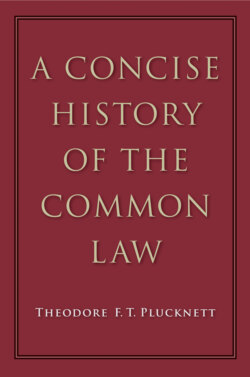Читать книгу A Concise History of the Common Law - Theodore F. T. Plucknett - Страница 85
На сайте Литреса книга снята с продажи.
THE EARLY HUNDRED
ОглавлениеThe term “hundred” occurs in various parts of Europe as an administrative unit, and great controversy has arisen as to its ultimate origin. Tacitus tells us of Germans organised by groups of hundreds; five centuries later the Frankish kings legislated on the “hundred” as a criminal jurisdiction (595); and the English hundred appears nearly four centuries later still (between 946 and 961). Tempting as it is to see some connection between these phenomena, the hazardous nature of such a speculation is emphasised by modern historians. One recent theory3 would stress the efforts made in the tenth century to enforce order by means of voluntary associations, such as London had set up.4 The members undertook police duties, and the Crown gave them a share in the property of convicted criminals, and powers to find out informally whether suspects were guilty. From this gild it was a short step to the ordinance ascribed to Edgar on the holding of the hundred.5 The principal change was to substitute regular judicial procedure and trial by ordeal for the gild’s informal inquiry. While that theory takes note of the documents, as they have come down to us, it is difficult to resist the suggestion that the hundred must be a good deal older than the texts mentioned. Sometimes a connection can be traced between a hundred and the tax assessment of 100 hides, and it may be that our texts show not the origin, but the re-modelling of an already ancient institution.
King Edgar commanded that the hundred should meet every four weeks; thieves are to be pursued and judgment executed upon them; contempt of the hundred’s decisions is punished by a fine and on the fourth offence by outlawry; in following the trail of stolen cattle one hundred may call upon another to assist; the hundred is ordered to establish fixed terms at which parties are to appear; fines were payable to it by those who disobeyed its commands, and half the property of convicted thieves also went to the hundred. The laws of Cnut (made between 1027 and 1034)6 show even more clearly how important the hundred was in Anglo-Saxon England. No distress was to be levied until the remedies available in the hundred had been exhausted: every freeman over twelve years of age was to be in a hundred; no one was to appeal to the King unless he was unable to get justice in the hundred; and until the famous ordinance1 of William the Conqueror, the bishop used the hundred to transact ecclesiastical business.
When we get to the Conquest the hundred is treated by the Norman administrators as the most convenient of the smaller units of government. The Dialogue of the Exchequer tells us2 of the rule long observed in that court as a result of the numerous assassinations of Normans, presumably by Englishmen. In order to check this it was ordained that every hundred wherein a Norman was found slain by an unknown hand should be liable to a very heavy murder fine. As time went on the hundred was allowed to relieve itself of the fine by proving that the dead man was not a Norman but an Englishman, but in the end the races had become so mingled that it was impossible to maintain this procedure of “presentment of Englishry” and the murder fine was abolished by Edward III. The principle of making the hundred liable in respect of undetected crimes was not abandoned, however, and the Statute of Winchester (1285) lays down a general rule that the whole of the hundred where a robbery was done shall be answerable for it unless they can produce the offender.3 For the next five hundred years Parliament constantly increased the civil liability of the hundred for crimes committed within its borders, especially by rioters, until in 1827 a long list of such statutes was repealed,4 and the hundred’s liability was restricted to damage done by rioters;5 later still the burden was placed on the county or borough rate-payers by the Riot (Damages) Act, 1886.
All this will serve to illustrate the varied aspects of mediaeval institutions, for besides this police and administrative side of the hundred, its judicial powers continued, although their decline came rather earlier. By the Assize of Clarendon (1166)6 it had been ordained that in every county and in every hundred the twelve most lawful men of each hundred and the four most lawful men of each vill should be sworn to present any man who was suspected of serious crime either to the King’s Justice or to the sheriff. If the hundred or the vill had been successful in capturing a suspect, they were to deliver him over, accompanied by two lawful men “to bear the record of the county or the hundred”—in other words to state verbally the circumstances under which the prisoner was captured. In 1234 a royal ordinance1 declared that hundred courts had been held too frequently and that rich and poor had been equally oppressed thereby; it was therefore ordained that they should meet every three weeks instead of once a fortnight as heretofore—it may be observed in passing that this is not the only complaint we hear during the middle ages of too many courts and too much justice; earlier still Henry II admitted that the country had suffered grievously “by reason of the multitude of justices, for they were eighteen in number”, reducing their number to five (1178).2
